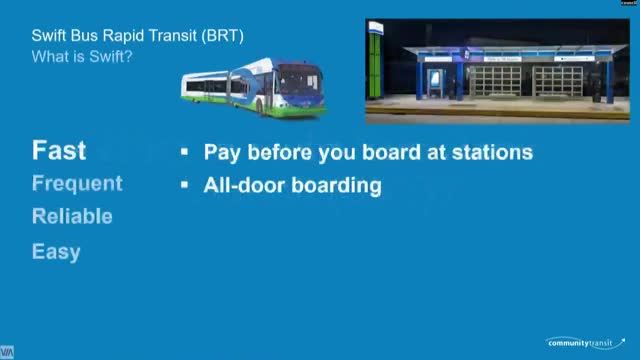Swift Gold Line set to revolutionize North County transit
August 01, 2024 | Everett, Snohomish County, Washington

This article was created by AI summarizing key points discussed. AI makes mistakes, so for full details and context, please refer to the video of the full meeting. Please report any errors so we can fix them. Report an error »

In a recent government meeting, officials discussed the ongoing success and future plans for the SWIFT bus rapid transit (BRT) system in Washington, highlighting its efficiency and growing ridership. Since its launch in 2009, SWIFT has distinguished itself by focusing on four key aspects: speed, frequency, reliability, and ease of use.
To enhance speed, SWIFT allows passengers to pay for their fares before boarding, utilizing ticket vending machines and ORCA card readers at stations. This system enables passengers to board through multiple doors, reducing wait times and increasing the overall efficiency of bus operations. The service operates frequently, with buses arriving every 10 minutes on weekdays and every 15 to 20 minutes on weekends.
Reliability is bolstered through investments in lane priority infrastructure, including bus access and transit lanes, as well as transit signal priority systems that allow buses to communicate with traffic signals for extended green lights. Additionally, real-time information displays at stations help passengers know exactly when their bus will arrive, further enhancing the user experience.
The meeting also addressed the impact of the pandemic on ridership. SWIFT demonstrated resilience, surpassing pre-pandemic ridership levels by 2022, with projections for continued growth in 2024 following the introduction of the new Swift Orange Line. Officials noted a significant increase in youth ridership, attributed to a statewide initiative offering free rides for children, which has resulted in youth making up approximately 20% of total ridership.
Looking ahead, the SWIFT Gold Line is in the scoping study phase, aiming to connect Everett, Marysville, and Arlington with high-frequency service. This project is designed to improve transit capacity and reliability in North County and will eventually link to the light rail at Everett Station. The planning phase is expected to conclude by late spring 2024, followed by environmental reviews and design work, with construction anticipated to begin thereafter, aiming for a service launch in 2029.
Overall, the meeting underscored the importance of integrating transportation infrastructure with regional growth plans, emphasizing the role of public transit in alleviating traffic congestion and supporting sustainable development.
To enhance speed, SWIFT allows passengers to pay for their fares before boarding, utilizing ticket vending machines and ORCA card readers at stations. This system enables passengers to board through multiple doors, reducing wait times and increasing the overall efficiency of bus operations. The service operates frequently, with buses arriving every 10 minutes on weekdays and every 15 to 20 minutes on weekends.
Reliability is bolstered through investments in lane priority infrastructure, including bus access and transit lanes, as well as transit signal priority systems that allow buses to communicate with traffic signals for extended green lights. Additionally, real-time information displays at stations help passengers know exactly when their bus will arrive, further enhancing the user experience.
The meeting also addressed the impact of the pandemic on ridership. SWIFT demonstrated resilience, surpassing pre-pandemic ridership levels by 2022, with projections for continued growth in 2024 following the introduction of the new Swift Orange Line. Officials noted a significant increase in youth ridership, attributed to a statewide initiative offering free rides for children, which has resulted in youth making up approximately 20% of total ridership.
Looking ahead, the SWIFT Gold Line is in the scoping study phase, aiming to connect Everett, Marysville, and Arlington with high-frequency service. This project is designed to improve transit capacity and reliability in North County and will eventually link to the light rail at Everett Station. The planning phase is expected to conclude by late spring 2024, followed by environmental reviews and design work, with construction anticipated to begin thereafter, aiming for a service launch in 2029.
Overall, the meeting underscored the importance of integrating transportation infrastructure with regional growth plans, emphasizing the role of public transit in alleviating traffic congestion and supporting sustainable development.
View full meeting
This article is based on a recent meeting—watch the full video and explore the complete transcript for deeper insights into the discussion.
View full meeting
